How to perform a MIL-STD-461 RE101 Radiated Emission test[edit]
This application note explains how the MIL-STD-461 RE101 Radiated Emission test can be performed with RadiMation®.
The "RE101, radiated emissions, magnetic field" test is applicable to equipment, subsystem enclosures and all interconnecting cables and is used to verify that the magnetic field emissions from the EUT and cabling do not exceed the specified requirements.
The exact requirements and test methods for the RE101 are specified in the MIL-STD-461.
Necessary equipment[edit]
The following devices are necessary to execute this test:
- Receiver
- Loop sensor (Antenna)
- LISN
- Cable
Configuration of the testsite[edit]
The configuration of the testsite is a loop sensor antenna connected with a cable to a receiver.
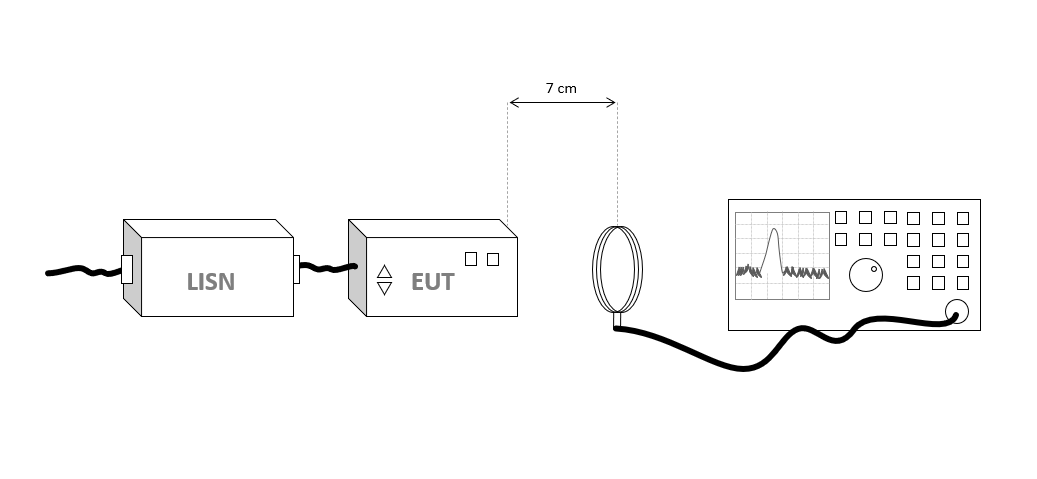
The configuration of the testsite should thus contain the following devices:
| Device name |
Tab in testsite configuration window |
note
|
| Antenna |
Devices 1 |
Loop sensor antenna for the required frequency range
|
| Spectrum Analyser |
Devices 2 |
The receiver used for the test
|
| Cable preamp -> analyser |
Cables |
Cable with a correction file specified for the loss
|

|
Note:
|
The LISN is only used to decouple the EUT and it is not needed to specify and configure this in RadiMation®
|
Configuration of the loop sensor antenna[edit]
The loop antenna needs to have the correction data applied, which is normally provided by the manufacturer, or a calibration institute. The correction data is expressed in dBpT/µV.
In RadiMation® this can be configured by creating a correction file, which contains a Frequency and a Correction column. The frequencies and the correction values of the actual correction of the loop antenna can then be specified in the correction file. The values in the Correction column in the correction should be expressed in dBpT/µV.
Convert k-factor from dB(S/m) or dB/(Ohm m) to dBpT/µV[edit]
Some calibration certificates of loop antennas contain the magnetic field factor of the loop antenna as a k-factor with a dB(S/m) unit or a dB/(Ohm m) unit (which are exactly the same to each other). RadiMation® expects that the values in the correction file are expressed in the dBpt/µV unit.
The conversion from dB(S/m) is: 'MagneticFieldFactor [dBpT/µV] = k [dB(S/m)] + 1.984'.
The conversion from dB/(Ohm m) is: 'MagneticFieldFactor [dBpT/µV] = k [dB/(Ohm m)] + 1.984'.
The value 1.984 is often simplified to be 2.0, but 1.984 is the more accurate value.

|
Note:
|
The relation between dBpT and A/m is: Magnetic Flux Density [dBpT] = Magnetic field [dBµA/m] + 1.984
In this equation, the constant 1.984 is derived by using: The magnetic flux density (B) in Tesla (T), is related to the magnetic field strength (H) in A/m, by the permeability of the medium ( ) in Henry's per meter (H/m). For free space, the permeability is given as: ) in Henry's per meter (H/m). For free space, the permeability is given as:
![{\displaystyle \mu _{0}[H/m]=4\pi \cdot 10^{-7}}](https://wikimedia.org/api/rest_v1/media/math/render/svg/dad599e83e90ef8644a433769cf58bc955647fea)
![{\displaystyle B[T]=\mu _{0}*H[A/m]}](https://wikimedia.org/api/rest_v1/media/math/render/svg/0d21bbbc9a4f1fd8cb1f31ce6180c7eb893f3274)
Converting from T to pT and from A/m to µA/m, and converting it to decibels, using the Log, the constant becomes:
 (to be exact: 1.9841972804419248955749215547977) (to be exact: 1.9841972804419248955749215547977)
Also see: https://www.tf.uni-kiel.de/matwis/amat/elmat_en/kap_4/backbone/r4_1_1.html
|

|
Note:
|
As RadiMation® only has a correction file for the magnetic field factor that contains the frequency and actual factor value, it is not known for RadiMation® at which distance this magnetic field factor has been calibrated. Recalculating it to another distance is thus not possible as the original calibration distance is not known. It thus is important that the correct magnetic field factor is specified, corresponding to the antenna distance that is actually used during the measurement.
If you would like to convert the magnetic field antenna factor from one distance to another distance, it is possible to use a 18 dB correction if the distance is doubled.
|
An example correction file for this 'Magnetic Field factor' thus looks like:
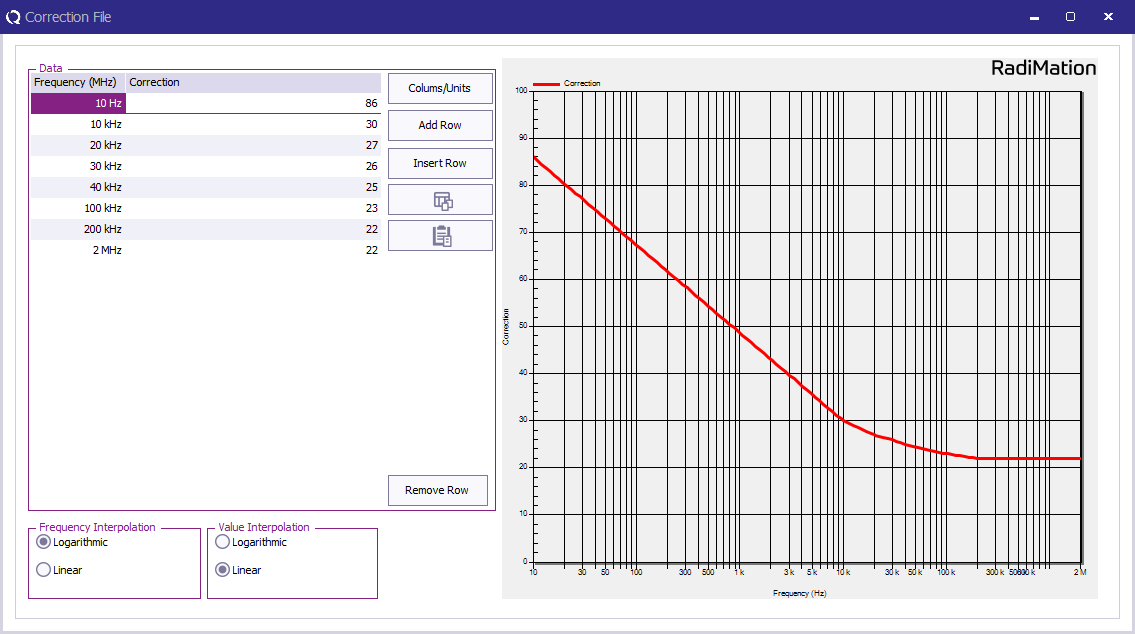
Once this correction is stored to disk, this correction file can be selected in the loop antenna driver configuration as 'Magnetic Field Factor':
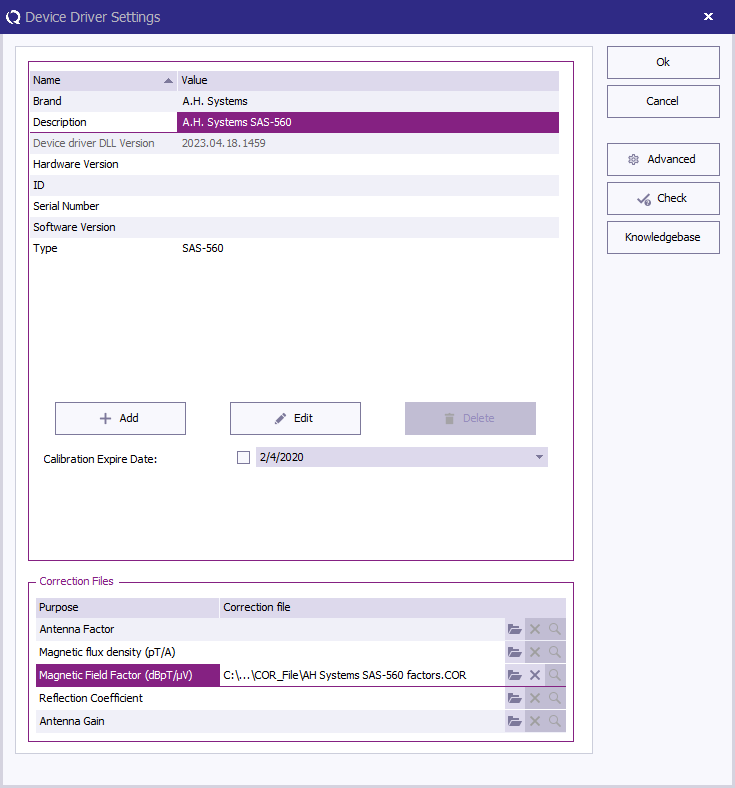
Perform the test[edit]
To perform the actual RE101 test, start a Radiated Emission Multiband test:
-
 Tests
Tests
-
 Radiated Emission
Radiated Emission
-
 Multiband
Multiband
The complete test from 30 Hz up to 150 kHz has different settings for different frequency bands. All these different bands can be configured.
The test can be configured with 3 bands, each using their applicable frequency range, measure time and bandwidth.
| Band |
Frequency range |
RBW |
Step size |
Measure time receiver |
Measure time FFT receiver
|
| Band 1 |
30 Hz - 1 kHz |
10 Hz |
5 Hz |
0.15 s |
1 s
|
| Band 2 |
1 kHz - 10 kHz |
100 Hz |
50 Hz |
0.015 s |
1 s
|
| Band 3 |
10 kHz - 150 kHz |
1 kHz |
500 Hz |
0.015 s |
1 s
|
In the following screenshot a configuration is shown to perform the measurement on an EUT, applicable for the Navy Application.
The Location type setting for every band should be set to Magnetic Field antenna, as that determines that the measurement result will be shown as magnetic field values.
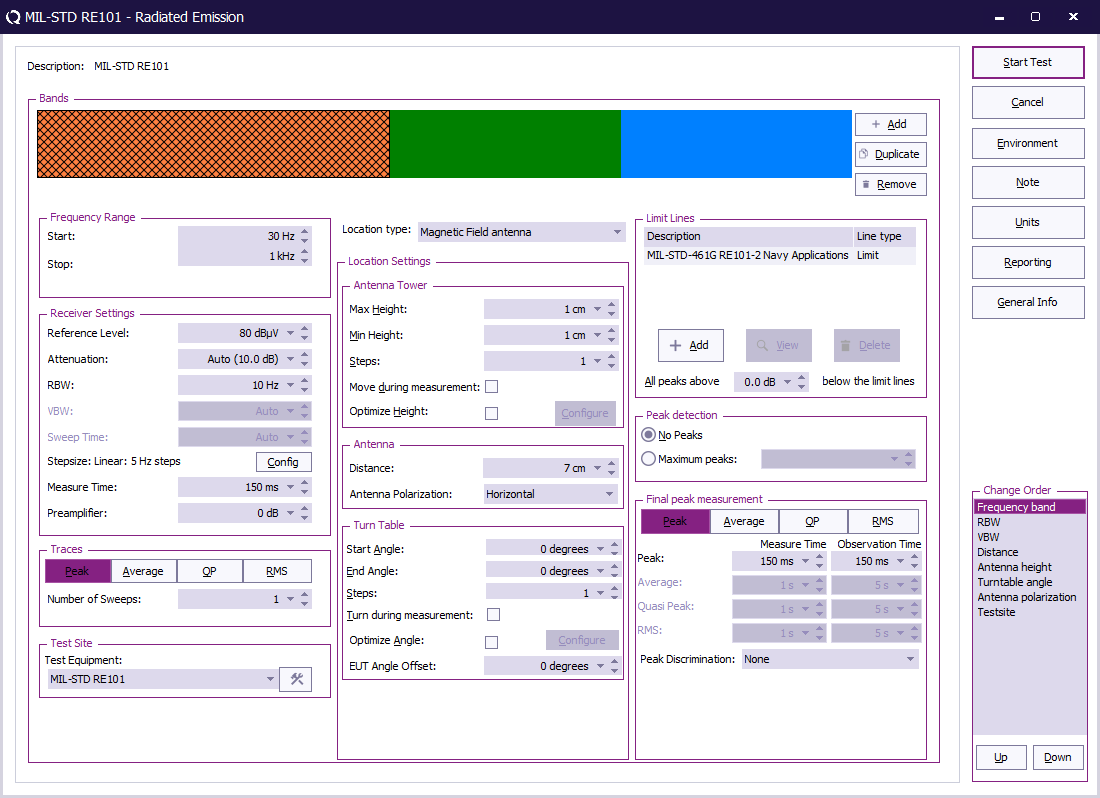
 Start Start
|
The start frequency of the test. For example 30 kHz.
|
 Stop Stop
|
The stop frequency of the test. For example 100 kHz.
|
 Reference Level Reference Level
|
The reference level set in an analyser. This setting is not used when a receiver is used.
|
 Attenuation Attenuation
|
The attenuation set in the receiver.
|
 RBW RBW
|
The RBW set in the receiver. See the table with different bands for the specific values for the RE101 measurement.
|
 Step size Step size
|
The step size set in the receiver. See the table with different bands for the specific values for the RE101 measurement.
|
 Measure time Measure time
|
The measure time set in the receiver. See the table with different bands for the specific values for the RE101 measurement.
|
 Preamplifier Preamplifier
|
The preamplifier setting set in the receiver.
|
 Traces Traces
|
The type of trace set in the receiver. For MIL-STD-461 RE101 only a peak detector is used.
|
 Test Equipment Test Equipment
|
The equipment used for the measurement.
|
 Location type Location type
|
The type of measurement that should be used. Set this to Magnetic Field antenna, as this will present the final result in dBpT or dBuA/m (depending on these selected unit).
|
 Max Height Max Height
|
The maximum height for the antenna tower. This configuration is depending on how many positions should be measured.
|
 Min Height Min Height
|
The minimal height for the antenna tower. This configuration is depending on how many positions should be measured.
|
 Steps Steps
|
The number of height positions to measure. This configuration is depending on how many positions should be measured.
|
 Move during measurement Move during measurement
|
If the antenna tower can move during the measurement. This is normally not used during MIL-STD-461 RE101 measurements, and can thus be unchecked.
|
 Optimize Height Optimize Height
|
Find the optimal emission around a certain height. This is normally not used during MIL-STD-461 RE101 measurements, and can thus be unchecked.
|
 Distance Distance
|
The distance between the antenna and the EUT. This is normally 7cm for a MIL-STD-461 RE101 measurement.
|
 Antenna Polarization Antenna Polarization
|
Which polarization is used, Vertical, Horizontal or Both.
|
 Start Angle Start Angle
|
The minimal turn table angle.
|
 End Angle End Angle
|
The maximum turn table angle.
|
 Steps Steps
|
The number of angles to measure.
|
 Turn during measurement Turn during measurement
|
If the turn table can move during the measurement. This is normally not used during MIL-STD-461 RE101 measurements, and can thus be unchecked.
|
 Optimize Angle Optimize Angle
|
Find the optimal emission around a certain angle. This is normally not used during MIL-STD-461 RE101 measurements, and can thus be unchecked.
|
 EUT Angle Offset EUT Angle Offset
|
The offset of the EUT on the table. This is normally not used during MIL-STD-461 RE101 measurements, and can thus be set to 0 degrees.
|
 Limit Lines Limit Lines
|
The applicable limit line can be added, in this example the "MIL-STD-461 RE101-2 Navy Applications" limit line file.
|
 All peaks above x dB below the limit line All peaks above x dB below the limit line
|
Which level above x dB below the limit line the peaks should be detected.
|
 Peak detection Peak detection
|
How many peaks should be detected automatically, for example, use 10 peaks to be detected
|
 Final peak measurement Final peak measurement
|
It is possible to perform a final measurement on a peak with the selected detectors. Normally no final measurement is needed for the MIl-STD-461 RE101 measurement, and all detectors can thus be unselected.
|
When all parameters are configured for the RE101 test, press Start Test to perform the actual emission measurement.
Review the initial scan and measure frequencies for maximum emission[edit]
With the the frequencies of maximum emission located, RadiMation® will detect any peaks above the limit line, but it is also possible to add additional peaks by clicking in the graph. A list of peaks with frequencies should appear below in the Peaks tab.
As described in section 5.17.3.4c(4) and 5.17.3.4c(5) it is needed to find the maximum radiation, the following steps describe how to perform this within RadiMation.
To measure one single frequency and find the maximum radiation:
- Select one frequency by checking one single frequency in the peaks list.
- Click Peak Actions and select Set receiver to Peak settings to set the correct measure time and RBW as configured.
- Enable Continuous Measure and move the loop antenna to find the maximum radiation.
- Click Continuous Measure again to stop the measurement.
- Repeat this step for each frequency.
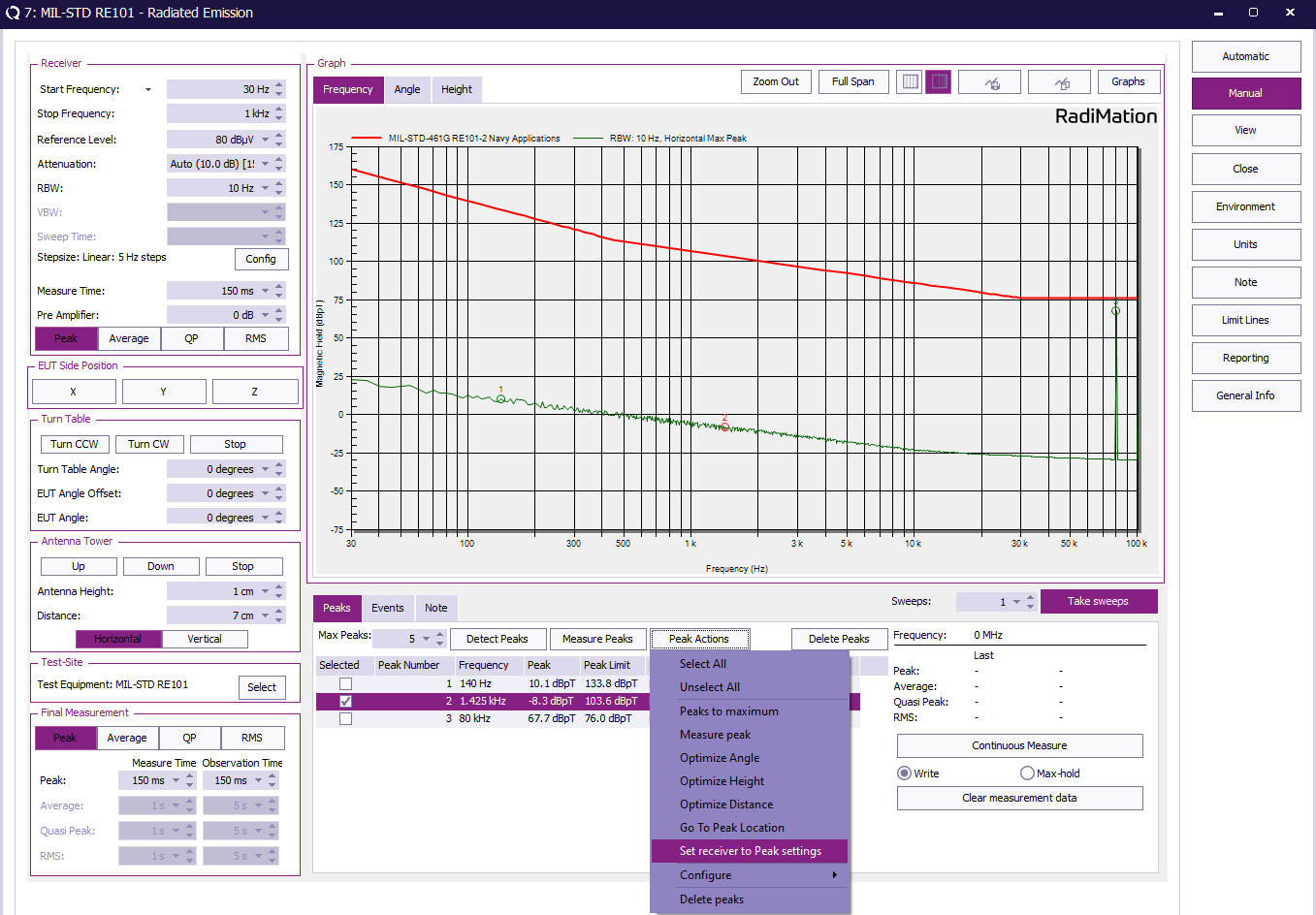
Conclusion[edit]
The MIL-STD-461 RE101 test is using different receiver settings depending on the frequency band to cover the measurement of the magnetic field for the complete frequency range. All these settings can be easily configured in a multiband "Test Setup File" and tested with RadiMation®. Also the optimization of the maximum emission can be performed, and all this information will be present in the peak table in the test results.
 Tests
Tests
 Radiated Emission
Radiated Emission
 Multiband
Multiband 

![{\displaystyle \mu _{0}[H/m]=4\pi \cdot 10^{-7}}](https://wikimedia.org/api/rest_v1/media/math/render/svg/dad599e83e90ef8644a433769cf58bc955647fea)
![{\displaystyle B[T]=\mu _{0}*H[A/m]}](https://wikimedia.org/api/rest_v1/media/math/render/svg/0d21bbbc9a4f1fd8cb1f31ce6180c7eb893f3274)




